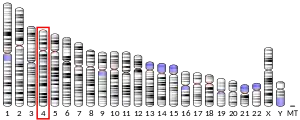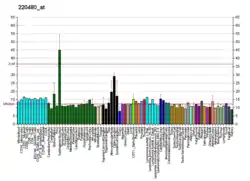Heart- and neural crest derivatives-expressed protein 2 is a protein that in humans is encoded by the HAND2 gene.[5][6]
Function
The protein encoded by this gene belongs to the basic helix-loop-helix family of transcription factors. This gene product is one of two closely related family members, the HAND proteins Hand1 and Hand2, which are asymmetrically expressed in the developing ventricular chambers and play an essential role in cardiac morphogenesis. Working in a complementary fashion, they function in the formation of the right ventricle and aortic arch arteries, implicating them as mediators of congenital heart disease. In addition, this transcription factor plays an important role in limb and branchial arch development.[6] In one study, it was found that a missense mutation of the Hand2 protein in patients with the congenital heart disease (CHD) Tetralogy of Fallot experienced significantly decreased Hand2 interactions with other key developmental genes such as GATA4 and NKX2.5.[7] Hand2 mutations have the potential to be genes for the future study of right ventricle stenosis and its pathogenesis.[8] In avian species, Hand2 has been shown to be expressed in developing gut tissue and is believed to contribute to the formation of enteric neurons.[9]
Hand2 also plays a critical role in the establishment of a proper implantation environment for pregnancy in mice and humans. The induction of Hand2 by progesterone-dependent mechanisms in uterine stromal tissue suppresses fibroblast growth factors (FGFs) that would otherwise stimulate estrogen producing pathways and impair embryo implantation.[10]
In addition, Hand2 also plays a role in lower jaw formation and tongue morphogenesis in mice by suppressing the homeobox genes Dlx5 and Dlx6.[11]
It has been recently suggested based on in vitro studies that HAND2 and its associated antisense long noncoding RNA HAND2-AS1 (partially overlapping HAND2 first exon and regulatory promotor region), may have an essential role in fine-tuning mesenchymal-to-epithelial/endothelial (MET) plasticity.[12] In that study basal expression levels of HAND2 were necessary to maintain human mesenchymal stem cell identity, high expression levels were associated with MET towards an endothelial phenotype, and complete knockout (KO) resulted in a senescent-like hypertrophic and cell-cycle arrested phenotypes. That same study also demonstrated by data mining and bioinformatic analyses the preservation of basal human HAND2/HAND2-AS1 expression levels across many different tissues, during embryonic development and in normal homeostatic adult tissue samples. They further demonstrated that deviation from those basal expression levels (up or down regulation) is associated with a long list of pathologies including many different metastasizing cancer types, which may be explained, at least in part by the speculative role of HAND2/HAND2-AS1 in regulation of MET states. Nevertheless, additional studies are required to further elucidate the involvement of HAND2/HAND2-AS1 in these processes, which may represent a promising therapeutic target for many related pathologies.
Interactions
HAND2 has been shown to interact with GATA4,[13] NKX2.5,[7] PPP2R5D,[14] PHOX2A.,[15] TWIST1, and TWIST2.
Clinical significance
Hand2 interactions with TWIST1 and TWIST2 genes are critical for proper limb development. Recent literature shows over dosage of Hand2 can result in many defects in the limbs, face, heart, and lower lumbar vertebrae. In this instance, trisomy of the hand2 gene can directly cause human congenital heart disease.[8]
Hand2 gene hypermethylation and epigenetic silencing has also been implicated to increase the development of endometrial cancer. Mounting evidence showing its methylation increased chances of premalignant endometrial lesions. Hand2, in addition to its other functions in the developing heart and limbs, has been found to be an important transcription factor seen in the endometrial stroma. In fact, in mice with the Hand2 gene knocked out, they developed premalignant lesions as they grew older, further providing evidence of its role in endometrial cancer development. These findings have led to Hand2 becoming a potentially promising biomarker for early detection of endometrial cancer and may be used to predict its treatment.[16]
Regulation of Hand2
HAND2 is an important transcription factor in development of the endothelial to mesenchymal transition (EMT) which allows for the development of the cardiac cushion in the atrioventricular canal which forms the mitral and tricuspid valves. The Hand2 gene regulatory network contains many genes that function in the EMT process, most notably Snail1, whose expression is lost if Hand2 is deficient. Since HAND2 is essential for separation of the atria and ventricles, a mutation in this gene has been linked to ventricular septal defects. Deficiency in HAND2 is only partially replaced by SNAIL1.[17] The expression of Hand2 is regulated by an upstream long non-coding RNA called Upperhand (Uph) that is needed for RNA polymerase II to transcribe Hand2. If Uph is not present, then there is a decrease in the expression of Hand2 and thus a decrease in cardiac development. When Uph was knocked out, the right ventricular chamber did not develop and had a similar phenotype as when Hand2 is knocked out. In addition, Hand2 expression was absent in the atria, ventricles, and outflow tract of the heart and was reduced in the brachial arches and limb buds.[18]
References
- 1 2 3 GRCh38: Ensembl release 89: ENSG00000164107 - Ensembl, May 2017
- 1 2 3 GRCm38: Ensembl release 89: ENSMUSG00000038193 - Ensembl, May 2017
- ↑ "Human PubMed Reference:". National Center for Biotechnology Information, U.S. National Library of Medicine.
- ↑ "Mouse PubMed Reference:". National Center for Biotechnology Information, U.S. National Library of Medicine.
- ↑ Russell MW, Kemp P, Wang L, Brody LC, Izumo S (December 1998). "Molecular cloning of the human HAND2 gene". Biochimica et Biophysica Acta (BBA) - Gene Structure and Expression. 1443 (3): 393–9. doi:10.1016/S0167-4781(98)00237-1. PMID 9878849.
- 1 2 "Entrez Gene: HAND2 heart and neural crest derivatives expressed 2".
- 1 2 Lu CX, Gong HR, Liu XY, Wang J, Zhao CM, Huang RT, Xue S, Yang YQ (February 2016). "A novel HAND2 loss-of-function mutation responsible for tetralogy of Fallot". International Journal of Molecular Medicine. 37 (2): 445–51. doi:10.3892/ijmm.2015.2436. PMID 26676105.
- 1 2 Shen L, Li XF, Shen AD, Wang Q, Liu CX, Guo YJ, Song ZJ, Li ZZ (July 2010). "Transcription factor HAND2 mutations in sporadic Chinese patients with congenital heart disease". Chinese Medical Journal. 123 (13): 1623–7. PMID 20819618.
- ↑ Wu X, Howard MJ (2002-01-01). "Transcripts encoding HAND genes are differentially expressed and regulated by BMP4 and GDNF in developing avian gut". Gene Expression. 10 (5–6): 279–93. doi:10.3727/000000002783992361. PMC 5977526. PMID 12450220.
- ↑ Li Q, Kannan A, DeMayo FJ, Lydon JP, Cooke PS, Yamagishi H, Srivastava D, Bagchi MK, Bagchi IC (February 2011). "The antiproliferative action of progesterone in uterine epithelium is mediated by Hand2". Science. 331 (6019): 912–6. Bibcode:2011Sci...331..912L. doi:10.1126/science.1197454. PMC 3320855. PMID 21330545.
- ↑ Barron F, Woods C, Kuhn K, Bishop J, Howard MJ, Clouthier DE (June 2011). "Downregulation of Dlx5 and Dlx6 expression by Hand2 is essential for initiation of tongue morphogenesis". Development. 138 (11): 2249–59. doi:10.1242/dev.056929. PMC 3091495. PMID 21558373.
- ↑ Vazana-Netzarim R, Elmalem Y, Sofer S, Bruck H, Danino N, Sarig U (January 2023). "Distinct HAND2/HAND2-AS1 Expression Levels May Fine-Tune Mesenchymal and Epithelial Cell Plasticity of Human Mesenchymal Stem Cells". International Journal of Molecular Sciences. 24 (22): 16546. doi:10.3390/ijms242216546. ISSN 1422-0067. PMC 10672054. PMID 38003736.
- ↑ Dai YS, Cserjesi P, Markham BE, Molkentin JD (July 2002). "The transcription factors GATA4 and dHAND physically interact to synergistically activate cardiac gene expression through a p300-dependent mechanism". The Journal of Biological Chemistry. 277 (27): 24390–8. doi:10.1074/jbc.M202490200. PMID 11994297.
- ↑ Firulli BA, Howard MJ, McDaid JR, McIlreavey L, Dionne KM, Centonze VE, Cserjesi P, Virshup DM, Firulli AB (November 2003). "PKA, PKC, and the protein phosphatase 2A influence HAND factor function: a mechanism for tissue-specific transcriptional regulation". Molecular Cell. 12 (5): 1225–37. doi:10.1016/S1097-2765(03)00425-8. PMID 14636580.
- ↑ Rychlik JL, Gerbasi V, Lewis EJ (December 2003). "The interaction between dHAND and Arix at the dopamine beta-hydroxylase promoter region is independent of direct dHAND binding to DNA". The Journal of Biological Chemistry. 278 (49): 49652–60. doi:10.1074/jbc.M308577200. PMID 14506227.
- ↑ Jones A, Teschendorff AE, Li Q, Hayward JD, Kannan A, Mould T, West J, Zikan M, Cibula D, Fiegl H, Lee SH, Wik E, Hadwin R, Arora R, Lemech C, Turunen H, Pakarinen P, Jacobs IJ, Salvesen HB, Bagchi MK, Bagchi IC, Widschwendter M (November 2013). "Role of DNA methylation and epigenetic silencing of HAND2 in endometrial cancer development". PLOS Medicine. 10 (11): e1001551. doi:10.1371/journal.pmed.1001551. PMC 3825654. PMID 24265601.

- ↑ Laurent F, Girdziusaite A, Gamart J, Barozzi I, Osterwalder M, Akiyama JA, Lincoln J, Lopez-Rios J, Visel A, Zuniga A, Zeller R (May 2017). "HAND2 Target Gene Regulatory Networks Control Atrioventricular Canal and Cardiac Valve Development". Cell Reports. 19 (8): 1602–1613. doi:10.1016/j.celrep.2017.05.004. PMC 5523860. PMID 28538179.
- ↑ Anderson KM, Anderson DM, McAnally JR, Shelton JM, Bassel-Duby R, Olson EN (October 2016). "Transcription of the non-coding RNA upperhand controls Hand2 expression and heart development". Nature. 539 (7629): 433–436. Bibcode:2016Natur.539..433A. doi:10.1038/nature20128. PMC 5261552. PMID 27783597.
Further reading
- Srivastava D (1999). "HAND proteins: molecular mediators of cardiac development and congenital heart disease". Trends in Cardiovascular Medicine. 9 (1–2): 11–8. doi:10.1016/S1050-1738(98)00033-4. PMID 10189962.
- Firulli AB, McFadden DG, Lin Q, Srivastava D, Olson EN (March 1998). "Heart and extra-embryonic mesodermal defects in mouse embryos lacking the bHLH transcription factor Hand1". Nature Genetics. 18 (3): 266–70. doi:10.1038/ng0398-266. PMID 9500550. S2CID 36413867.
- Firulli BA, Hadzic DB, McDaid JR, Firulli AB (October 2000). "The basic helix-loop-helix transcription factors dHAND and eHAND exhibit dimerization characteristics that suggest complex regulation of function". The Journal of Biological Chemistry. 275 (43): 33567–73. doi:10.1074/jbc.M005888200. PMC 2561327. PMID 10924525.
- McFadden DG, Charité J, Richardson JA, Srivastava D, Firulli AB, Olson EN (December 2000). "A GATA-dependent right ventricular enhancer controls dHAND transcription in the developing heart". Development. 127 (24): 5331–41. doi:10.1242/dev.127.24.5331. PMID 11076755.
- Dai YS, Cserjesi P (April 2002). "The basic helix-loop-helix factor, HAND2, functions as a transcriptional activator by binding to E-boxes as a heterodimer". The Journal of Biological Chemistry. 277 (15): 12604–12. doi:10.1074/jbc.M200283200. PMID 11812799.
- Dai YS, Cserjesi P, Markham BE, Molkentin JD (July 2002). "The transcription factors GATA4 and dHAND physically interact to synergistically activate cardiac gene expression through a p300-dependent mechanism". The Journal of Biological Chemistry. 277 (27): 24390–8. doi:10.1074/jbc.M202490200. PMID 11994297.
- Srivastava D, Gottlieb PD, Olson EN (2003). "Molecular mechanisms of ventricular hypoplasia". Cold Spring Harbor Symposia on Quantitative Biology. 67: 121–5. doi:10.1101/sqb.2002.67.121. PMID 12858532.
- Rychlik JL, Gerbasi V, Lewis EJ (December 2003). "The interaction between dHAND and Arix at the dopamine beta-hydroxylase promoter region is independent of direct dHAND binding to DNA". The Journal of Biological Chemistry. 278 (49): 49652–60. doi:10.1074/jbc.M308577200. PMID 14506227.
- Firulli BA, Howard MJ, McDaid JR, McIlreavey L, Dionne KM, Centonze VE, Cserjesi P, Virshup DM, Firulli AB (November 2003). "PKA, PKC, and the protein phosphatase 2A influence HAND factor function: a mechanism for tissue-specific transcriptional regulation". Molecular Cell. 12 (5): 1225–37. doi:10.1016/S1097-2765(03)00425-8. PMID 14636580.
- Murakami M, Kataoka K, Tominaga J, Nakagawa O, Kurihara H (October 2004). "Differential cooperation between dHAND and three different E-proteins". Biochemical and Biophysical Research Communications. 323 (1): 168–74. doi:10.1016/j.bbrc.2004.08.072. PMID 15351717.
- Rychlik JL, Hsieh M, Eiden LE, Lewis EJ (2006). "Phox2 and dHAND transcription factors select shared and unique target genes in the noradrenergic cell type". Journal of Molecular Neuroscience. 27 (3): 281–92. doi:10.1385/JMN:27:3:281. PMID 16280598. S2CID 1021814.
- Han Z, Yi P, Li X, Olson EN (March 2006). "Hand, an evolutionarily conserved bHLH transcription factor required for Drosophila cardiogenesis and hematopoiesis". Development. 133 (6): 1175–82. doi:10.1242/dev.02285. PMID 16467358.
External links
- HAND2+protein,+human at the U.S. National Library of Medicine Medical Subject Headings (MeSH)
This article incorporates text from the United States National Library of Medicine, which is in the public domain.




